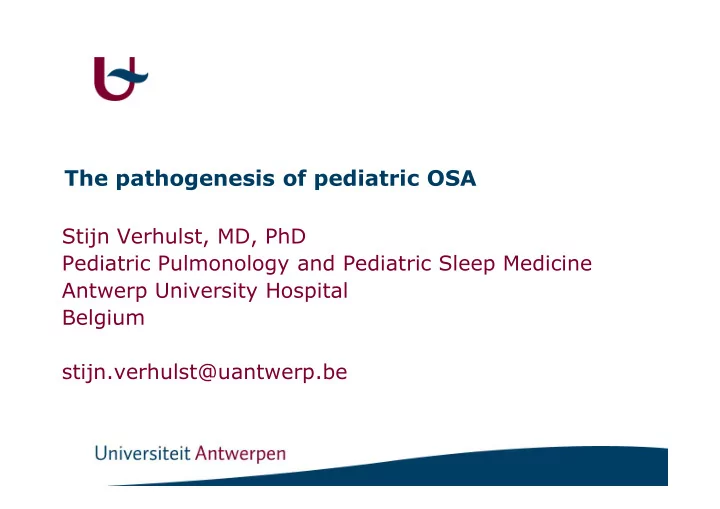

The pathogenesis of pediatric OSA Stijn Verhulst, MD, PhD Pediatric Pulmonology and Pediatric Sleep Medicine Pediatric Pulmonology and Pediatric Sleep Medicine Antwerp University Hospital Belgium stijn.verhulst@uantwerp.be
Introduction • Combinatie kritische anatomie en additionele risicofactoren 1
Introduction • This presentation will focus on 3 parts of the pathogenesis that are becoming increasingly clinically relevant: , The role of obesity as an anatomical risk factor , The role of obesity as an anatomical risk factor , The role of upper airway inflammation , Natural history 2
OBESITY 3
Prevalence • Childhood obesity is associated with an increased prevalence of obstructive sleep apnea. increased prevalence of obstructive sleep apnea. 4
5
Prevalence ���������������������������������������������� 6
Prevalence • Both childhood obesity and OSAS are associated with a number of complications. • Second, obesity and OSAS can interact in • Second, obesity and OSAS can interact in causing these complications, i.e. cardiovascular and metabolic complications. 7
KEY MESSAGE: An optimal treatment should therefore target both conditions. This requires a good knowledge of the (individual) contributing anatomical factors. 8
Anatomical correlates • The exact contributions of both adenotonsillar hypertrophy and obesity to the pathogenesis of OSAS are still controversial. of OSAS are still controversial. 9
The scope of the problem �������������������������������������������� 10
Anatomical correlates • However, the relation between obesity and sleep apnea in children is complex… sleep apnea in children is complex… 11
Anatomical correlates • AHI is not a unique marker of OSAS: BMI often correlates better with other markers of the severity of sleep apnea, i.e. oxygen desaturation. ������������������������������������������������������ 12
Anatomical correlates oAHI < 2 2 < oAHI < 5 oAHI ≥ 5 P VC (%pred) 106 ± 13 103 ± 13 95 ± 15 0.01 FEV 1 (%pred) 104 ± 13 101 ± 14 95 ± 17 0.05 FEV 1 /VC 99 ± 8 98 ± 7 101 ± 7 0.4 (%pred) RV He (%pred) 89 ± 36 86 ± 35 85 ± 26 0.6 TLC He (%pred) 101 ± 21 101 ± 11 91 ± 20 0.03 FRC He (%pred) 82 ± 21 76 ± 31 65 ± 21 0.008 ����!"�#��������������������������������� 13
Anatomical correlates • Second, BMI is not the only marker of obesity. However, there is limited data on the association between OSAS and markers of association between OSAS and markers of visceral adiposity in children. 14
�������� ��������$���%������������������ ����� ������������&& 15
'��������������(�� %�)������ *+������&& 16
Anatomical correlates • Furthermore, the association seems to be age, dependent: , Obese children: Adenotonsillar hypertophy > Obesity , Obese teenagers: Obesity > Adenotonsillar hypertrophy �������������������������������������������� 17
Anatomical correlates 18
Anatomical correlates ��""�� ������������������, 19
Anatomical correlates ��""���������������������, 20
Anatomical correlates • The magnitude of adenotonsillar hypertrophy is more likely to be smaller in obese children compared to nonobese children with comparable AHI. • Increased Mallampati scores in obese children suggest that soft,tissue changes and potentially fat deposition in the upper airway may play a significant role in obese children with OSA. ��""���������������������, 21
Anatomical correlates ����� ���������%��������&& 22
Anatomical correlates ����� ���������%��������&& 23
Anatomical correlates: treatment data ��������������*�����"�-���-".'��������/��#����-��"�����, 24
Anatomical correlates: treatment data ��������������*�����"�-���-".'��������/��#����-��"�����, 25
Anatomical correlates: treatment data •Multi,center retrospective study investigated the outcome of adenotonsillectomy for OSAS in 578 children (50% obese): , AHI significantly dropped from 18.2 ± 21.4 to 4.1 ± 6.4 (p<0.001). , Only 157 (27.2%) had complete resolution of OSAS (AHI<1). 0���������1���������2�������%��������������������"�������������������������������&� 26
Anatomical correlates: treatment data 0���������1������������2�������%��������������������"�������������������������������&� 27
28
29
Anatomical correlates: treatment data ��������������*+����"��������������3 30
Anatomical correlates: treatment data • 61 obese teenagers. • 50% with OSAS. • After 6 months, these subjects lost an average of 24 kg which corresponded to a relative of 24 kg which corresponded to a relative decrease in BMI of approximately 30%. �����������������*+����"�����,� 31
Anatomical correlates: treatment data Definition of success Success rate (%) Apnea hypopnea index ≤ 2 62 Oxygen desaturation index ≤ 2 81 Apnea hypopnea index ≤ 5 91 �����������������*+����"�����,� 32 �����������������*+����"����������
Anatomical correlates: treatment data ����'�����+���# ��������)�������������&4 33 �����������������*+����"����������
34
Functional imaging 35
Obesity , conclusion • The pathogenesis of OSA in obese children is complex illustrated by suboptimal response to adenotonsillectomy. • In view of the established link with metabolic • In view of the established link with metabolic and cardiovascular morbidity, there is a clear need to validate tools that identify the anatomical contributors in the individual child. 36
Obese child Obese child with OSA with OSA Weight Weight management management Work up site Work up site of of of of obstruction obstruction T&A T&A Non,invasive Non,invasive ventilation ventilation 37
Obesity , conclusion 38
UPPER AIRWAY INFLAMMATION 39
Introduction • The size of tonsils and adenoids increases from birth to approximately 12 years of age. • There is gradual concomitant growth in the size of the skeletal boundaries of the upper airway. airway. • Between 2 and 8 years of age, the tonsils and adenoids are the largest in relation to upper airway size, resulting in a relatively narrower upper airway. 40
Introduction • However, despite this relative physiological narrowing, young children exhibit less collapsible upper airways when compared with adults: adults: , Increased tonic activation UA muscles , Increased central ventilatory drive 41
Introduction • Classical stimuli for proliferation: , Environmental irritants , Recurrent infections 42
Kheirandish,Gozal et al, Expert Opin Investig Drugs, 2013 43
44
45
46
• Cysteinyl leukotriene receptors are expressed by small,size B,lymphocytes in the tonsillar • mantle zones and by T,lymphocytes in the tonsillar extrafollicular areas. tonsillar extrafollicular areas. • Since these are immunologically active areas participating in the generation of mature germinal centers, it is proposed that cysteinyl • leukotriene receptors are involved in the pathogenesis of lymphoid tissue hyperplasia. 47
48
49
50
51
52
53
UA inflammation , conclusion • Increased UA inflammation – leukotrien modified. • Pharmacological treatment is an alternative to adentonsillectomy. • More data needed. 54
NATURAL HISTORY 55
56
Recommend
More recommend